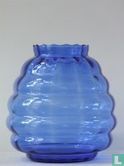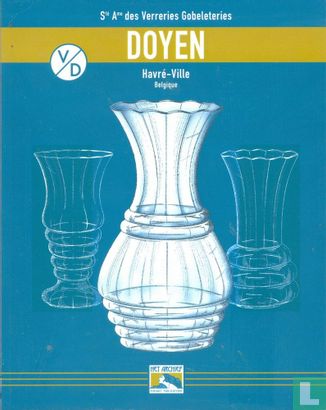

Enlarge image
Doyen Floralie No. (onbekend)


Catalogue information
LastDodo number
4093093
Area
Glass / crystal
Title
Doyen Floralie No. (onbekend)
Factory
Collection / set
Item
Model
Number
Designer
Country
Colour
Year
Dimensions
26 hoog diameter 23 cm
Details
Identifying Doyen's Floralies
So far the dates of Floralies production are unclear but it seems likely that the drawings date between 1933-1939 and the results produced over a longer period, (though to the 1950's or even 60's?)
The Floralies label was also frequently used and often survives and this will enable collectors to identify some further models which are unquestionably from the Doyen factory.
These vases were produced using the two-mould process to create vertical bands of deeper-colour and a second mould containing the outer shape and horizontal ribs. Purple is the most common colour although it seems likely that amber, turquoise and fumi were also typical. The tint and depth of colour is extremely variable from pale to dark (almost black).
Changeable designs
It is clear that there are also many 'variant forms' to be found. often the vases were produced with two bands or three bands, positioned higher or lower onto the basic outlines, and at a wide range of sizes. It is not entirely certain that all of these variants come from the Doyen factory, (similar work is thought to have originated at other factories nearby such as Braine-le-comte, Scailmont, Manage and Boussu) and there is very limited documentation available to support precise identification.
It is very possible that the design variations ocurred not from the pen of a 'designer' but rather in the making of the molds. Each time the molds were remade, new variations could have been introduced at the discretion of the 'moldmaker'.
The vases from these factories almost always have a beaded, sculpted and/or decorated rim (which can be considered generic to this group of designs). Softer scrolls and wave patterns are used sometimes for rims as well as round beading, pinched-pinking, scalloping, castellation or v-shaped grooves.
Changeable designs
It is clear that there are also many 'variant forms' to be found. often the vases were produced with two bands or three bands, positioned higher or lower onto the basic outlines, and at a wide range of sizes. It is not entirely certain that all of these variants come from the Doyen factory, (similar work is thought to have originated at other factories nearby such as Braine-le-comte, Scailmont, Manage and Boussu) and there is very limited documentation available to support precise identification.
It is very possible that the design variations ocurred not from the pen of a 'designer' but rather in the making of the molds. Each time the molds were remade, new variations could have been introduced at the discretion of the 'moldmaker'.
The vases from these factories almost always have a beaded, sculpted and/or decorated rim (which can be considered generic to this group of designs). Softer scrolls and wave patterns are used sometimes for rims as well as round beading, pinched-pinking, scalloping, castellation or v-shaped grooves.
The similarities between the local factories make it difficult to be sure about Doyen as manufacturer of these vases!
Although no surviving documentation has been found yet, it is very likely that the Doyen factory also produced gaslamp shades (funnels), lampshades and the distinctive beer-glasses associated with local brands.
It is likely that the factory sometimes supplied blanks to external decoration studios, such as the one at Laeken where young girls and women applied decorative finishes, painted gold rings, etc. etc.
Bron: http://www.hogelandshoeve.nl/index46.html



